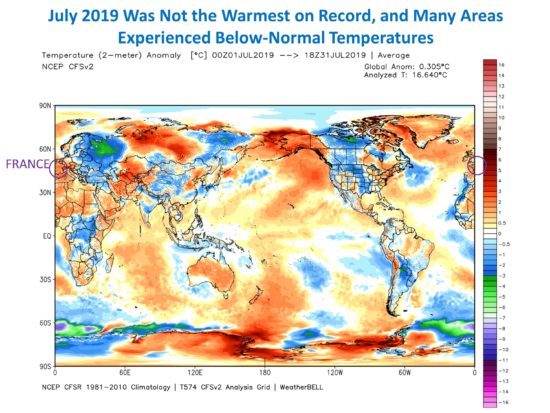a summary of the recent greenland melt
interesting reading
Europe’s warm air spikes Greenland melting to record levels
Featured
August 6, 2019
Warm air from Europe’s heat wave reached Greenland on July 29 and 30, setting temperature records at Summit Station and melting about 90 percent of the ice sheet surface from July 30 to August 3. Melt runoff was estimated at 55 billion tons during the interval, or about 40 billion tons more than the 1981 to 2010 average for the same time period. Overall, melting this July was much higher than average, leading to more extensive bare ice and flooded snow areas.
Overview of conditions
 Figure 1a. The top left map shows melt extent for Greenland on July 31, the peak of the recent warm event. The map includes temperatures at local noon for that day from several Programme for Monitoring of the Greenland Ice Sheet (PROMICE) weather stations. The top right map shows the total number of melt days for January 1 to August 3, 2019. The bottom panel shows the melt area day-by-day for 2019 (blue) and several other high-melt years.
Figure 1a. The top left map shows melt extent for Greenland on July 31, the peak of the recent warm event. The map includes temperatures at local noon for that day from several Programme for Monitoring of the Greenland Ice Sheet (PROMICE) weather stations. The top right map shows the total number of melt days for January 1 to August 3, 2019. The bottom panel shows the melt area day-by-day for 2019 (blue) and several other high-melt years.
Credit: National Snow and Ice Data Center
High-resolution image
 Figure 1b. This graph shows the cumulative surface melting area for 2019 and several of the most recent years.
Figure 1b. This graph shows the cumulative surface melting area for 2019 and several of the most recent years.
A rapid increase in surface melting on the Greenland ice sheet began on July 30 and continued through August 3, covering primarily the central and northern areas of the ice sheet on both the east and west ice sheet slopes. On July 30 and 31, melting reached the Summit Camp area of the ice sheet, corroborated by both air temperature from the National Oceanic and Atmospheric Administration (NOAA) weather station at Summit and the passive-microwave melt analysis. Peak melt area occurred on July 31, with just over 60 percent of the ice sheet surface experiencing melt (Figure 1a). Over the course of the five-day event approximately 90 percent of the surface of Greenland reached the melting point at least once.
Cumulatively, the 2019 season sum of melt area for every day is tracking well behind 2012, the satellite-era record for total melt-day area, and slightly behind 2016 (Figure 1b). However, total ice mass loss for 2019 is nearly equal to 2012 because of low winter snowfall. Early melting of the surface in 2019 quickly removed the snow accumulation from winter, and deeper melting this month has eroded older snow and ice over large areas of the western side of Greenland.
interesting reading
Europe’s warm air spikes Greenland melting to record levels
Featured
August 6, 2019
Warm air from Europe’s heat wave reached Greenland on July 29 and 30, setting temperature records at Summit Station and melting about 90 percent of the ice sheet surface from July 30 to August 3. Melt runoff was estimated at 55 billion tons during the interval, or about 40 billion tons more than the 1981 to 2010 average for the same time period. Overall, melting this July was much higher than average, leading to more extensive bare ice and flooded snow areas.
Overview of conditions
 Figure 1a. The top left map shows melt extent for Greenland on July 31, the peak of the recent warm event. The map includes temperatures at local noon for that day from several Programme for Monitoring of the Greenland Ice Sheet (PROMICE) weather stations. The top right map shows the total number of melt days for January 1 to August 3, 2019. The bottom panel shows the melt area day-by-day for 2019 (blue) and several other high-melt years.
Figure 1a. The top left map shows melt extent for Greenland on July 31, the peak of the recent warm event. The map includes temperatures at local noon for that day from several Programme for Monitoring of the Greenland Ice Sheet (PROMICE) weather stations. The top right map shows the total number of melt days for January 1 to August 3, 2019. The bottom panel shows the melt area day-by-day for 2019 (blue) and several other high-melt years. Credit: National Snow and Ice Data Center
High-resolution image
 Figure 1b. This graph shows the cumulative surface melting area for 2019 and several of the most recent years.
Figure 1b. This graph shows the cumulative surface melting area for 2019 and several of the most recent years. A rapid increase in surface melting on the Greenland ice sheet began on July 30 and continued through August 3, covering primarily the central and northern areas of the ice sheet on both the east and west ice sheet slopes. On July 30 and 31, melting reached the Summit Camp area of the ice sheet, corroborated by both air temperature from the National Oceanic and Atmospheric Administration (NOAA) weather station at Summit and the passive-microwave melt analysis. Peak melt area occurred on July 31, with just over 60 percent of the ice sheet surface experiencing melt (Figure 1a). Over the course of the five-day event approximately 90 percent of the surface of Greenland reached the melting point at least once.
Cumulatively, the 2019 season sum of melt area for every day is tracking well behind 2012, the satellite-era record for total melt-day area, and slightly behind 2016 (Figure 1b). However, total ice mass loss for 2019 is nearly equal to 2012 because of low winter snowfall. Early melting of the surface in 2019 quickly removed the snow accumulation from winter, and deeper melting this month has eroded older snow and ice over large areas of the western side of Greenland.








